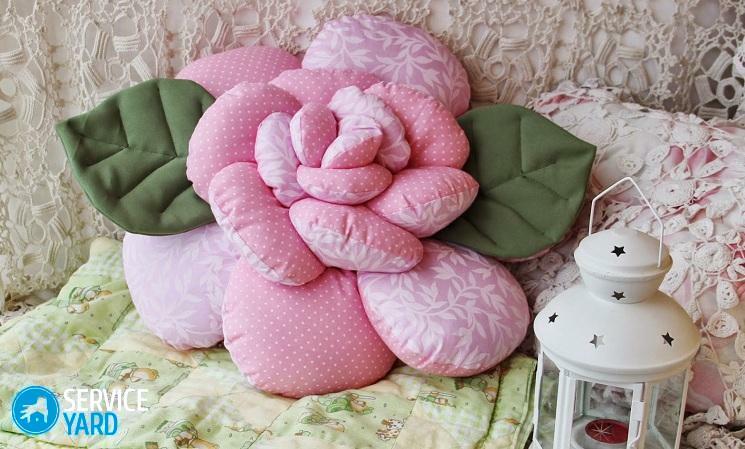
- What can be done from old things?
- What else do you need?
- Variants of pillows
- Pattern of a pillow of a rose by own hands
- Open
- How to make a pillow-rose if all details already are?
- Pillow of two layers
Pillows in the form of flowers give the room a special charm. They effectively look on the couch and armchair. To sleep on such, however, is not very convenient, but similar products for sleep and are not designed, they carry an exclusively decorative function. On how to sew a pillow-rose, you will learn from our article.
to the contents ↑What can be done from old things?
So, a flower cushion with your own hands - the master class begins. If you first took up needlework, it's better not to rush into the store for expensive expensive fabric, and see what you have in your closet. Many women who are not inclined to limit themselves in clothes, the cabinet sometimes bursts with things that you do not want to wear, but throw it away. It is possible that there will be:
- old, but strong silk or chiffon dress;
- an obsolete skirt made of artificial velvet;
- is a beautiful, but uncomfortable blouse made of synthetics.
It's time to give them a second life, turning into something spectacular for the house.
Cooking fabric
In order for a thing to be used in a new quality, it must be processed:
- Carefully cut off all the buttons, buttons and hooks.
- Remove the threads.
- Be sure to seam the product at the seams, not forgetting the darts, cuffs, collar and other small details.
- What you do not need with a guarantee is never better - just throw it away.
- Pieces of fabric thoroughly wash, if necessary iron.
- If there are damaged areas, remove them.
Important! Regardless of whether you buy a new fabric or decide to use old clothes, the material must meet certain requirements:
- it must be thin, but dense and not very crumbling;
- it is better to take a monophonic fabric or with a small pattern, otherwise - the shape will be poorly visible.
The ability to change dimensions after washing does not play a big role, although a new cotton or linen is useful before work to wash or iron through a damp cloth.
to the contents ↑What else do you need?
To make a flower cushion with your hands turned out effective and quality, you will need several more things:
- sewing machine;
- needles suitable for this fabric;
- sewing thread of appropriate quality;
- threads of contrasting color for basting;
- needle for manual sewing;
- sintepon or thin foam;
- braid - in tone or contrast;
- cardboard for the template;
- ruler;
- Compasses;
- ballpoint pen.
Braid
Braid can be of two types - thin for processing the edges of the petals and wide to cover the middle. With petals, you can do otherwise - for example, to trim them with a narrow lace. As for the amount, it will need about 15 m.

Synthepone and
Syntepon threads need about 3 m. You can, of course, fill in petals and thin sheet foam, but this option is worse - over time this material starts to release substances that are not very useful forhealth. Synthepone is absolutely neutral, so that the rose pillow will serve you, with your own hands, until the cloth disintegrates.
Important! Details filled with this material can be stacked with assemblies, and just for this product it is very important.
It is better to choose the thread for a specific fabric. Cotton or linen is more convenient to sew cotton, the rest - synthetic.
Important! If you want to connect several parts from different materials - synthetic threads( not kapron) are preferable.
to the table of contents ↑Variants of pillows
The rose cushion is made of several petals. The number of them depends on the size of the product:
- A small pillow( for example, for a doll's corner or a baby crib) consists of 5-6 petals, laid out in one layer.
- The product for a sofa consists of 8 or even 12 identical elements.
Important! And in that, and in another case they are attached to the middle - a two-layered circle.
to the table of contents ↑Pattern of a rose pillow with your own hands
Any sewing starts with cutting. Decorative pillow in this sense is not an exception. There are only two variants of cutting:
- all the petals are the same in shape and size;
- pillow consists of two layers, and the upper petals are smaller than the lower ones.
In the first case, one template is required, in the second case, two, but they differ only in size. By the way, according to the same principle, a chamomile pillow is sewn by own hands, and a poppy, and any other flower - they will differ only in the form of petals.
Important! You can make and petals of different shapes, but it is important that one side, which is sewn to the middle, be straight.
Making a pattern
You can, of course, find a pattern of a rose petal and on the Internet or a book on needlework, increase to the desired size and cut. But there is nothing difficult to draw with your own hands:
- Put a sheet of cardboard format about A4 on the table with a short side to yourself.
- From the top right corner, set aside 3 cm.
- Find the middle of the upper short side, mark it with a dot.
- From the top left corner, set aside 8 cm and make another mark.
- Connect the three points to an arc.
- From the lower right corner, put upwards 1 cm.
- Connect this point to the lower left corner with a smooth line.
- Connect the same point with the beginning of the upper arc, that is, with a point that is 8 cm from the corner on the left long side.
- Cut the pattern along the path.
Important! For a smaller petal, first cut out a rectangle, for example, by decreasing the standard sheet by ⅓ vertically and horizontally. It's okay if the petals are slightly different from each other in shape.
Middle pattern
This is even simpler than the pattern of the petal. You only need to cut out a circle:
- If you were making petals from a sheet of A4 size, a circle with a diameter of 10-15 cm would suit the middle, if you are sewing a rose.
- The daisy middle will be more.
There are no hard correlations, the main thing is to observe approximate sizes.
to the table of contents ↑Cutting
Decorative pillow-rose by your own hands - the master class continues. And it's time to cut the petals. For a small pillow, all parts of which will sew from the same fabric, the procedure will be as follows:
- If the cut is large, fold it in half with the wrong side out.
- Fold the two pieces face to face with each other.
- Circle the pattern strictly along the path.
- Cut out the details, making allowances of 1-1.5 cm in all sections.
- Cut the gaskets from the synthepon - from 2 to 6 per each petal, allowances are not needed.
Important! You can cut out the middle of the same fabric on a round pattern, not forgetting the allowances. The layers of the sintepon can be more so that this part looks more voluminous.
Pillow with two layers of petals
In this case, you need to find 4 large petals and 4 smaller ones - only 8 parts. In all other respects, the order of cutting is exactly the same as for the first variant. The smaller the pillow, the thinner the petals will be. The lower ones can be made more voluminous, for the upper ones 2-4 layers of packing are sufficient.
Important! If you use foam rubber, only one layer is laid in all the petals and in the middle.
to the contents ↑How to make a pillow-rose if all the details already exist?
And now it's time to arrange each element, then to collect them all together.
Mid
Let's start with the middle:
- Cut a piece of wide braid about 3 times the circumference.
- On the long edge, sew with a spot weld and make the assembly so that along the length it corresponds to the edge of the workpiece.
- The allowances of both parts are pressed to the wrong side, if necessary - cuts so that the fabric does not fray.
- To the detail that will be on top, on the wrong side, sweep the braid.
- Fold the parts with the wrong sides to each other, padding the sintepon between them so that it is under the allowances.
- Sweep the structure 1.5 cm from the edge so that you can insert the petals between the layers.

Petals
Each petal is treated in much the same way as the middle, but there are differences:
- Fold the details of the petal with faces facing each other, aligning all the slices.
- Sweep them around the rounded edge and stitch it.
- In several places, cut the allowances close to the seam.
- Remove the workpiece.
- The allowances for the open edge should be flattened.
- Insert the sintepon.
- Pull the notch along the open edge.
Important! If you decide to trim the edges with braid or lace, the finish should be inserted between the layers so that it protrudes from the front side with a straight line.
Assembling
Before sewing the flower cushion into a single product, slightly remove the tie. Then proceed as follows:
- Sweep the open edge of the petal between the layers of the middle.
- Attach the rest of the petals in the same way, pulling up the tie and, if necessary, laying out beautiful assemblies.
- Stitch the entire structure along the edge of the middle with a zigzag or decorative stitch.
Two-layer cushion
The manufacturing procedure differs little from that described in the previous case, but there are some features. With the middle should do the same, that is:
- cut 2 parts;
- to the top to sweep the braid, pre-folding it;
- to enclose a sintepon;
- sweep the details and put it all aside for a while.
The order of making petals also does not differ. It's important to do them all before you start the final assembly, which will be somewhat different:
- Insert between the layers of the middle all the large petals, that is, those that will be from below - the length of the open edge is adjusted by the assemblies.
- Sweep them to the bottom layer of the middle.
- Place the upper petals so that they are in the spaces between the lower ones.
- Sweep them to the top layer of the middle.
- Tare the workpiece along the edge of the middle.
Important! Since you are not going to sleep on such a pillow - you can decorate the middle. Suitable embroidery, applique, sewing beads, large beads and much more.
As you can see, it's quite possible to make with your own hands an interesting decor for decorating a sofa in the living room or bed in the bedroom, the nursery. The main thing is to show your imagination, pick up the right fabric and spare no time, carefully making the cutting of materials and sewing the parts together.


